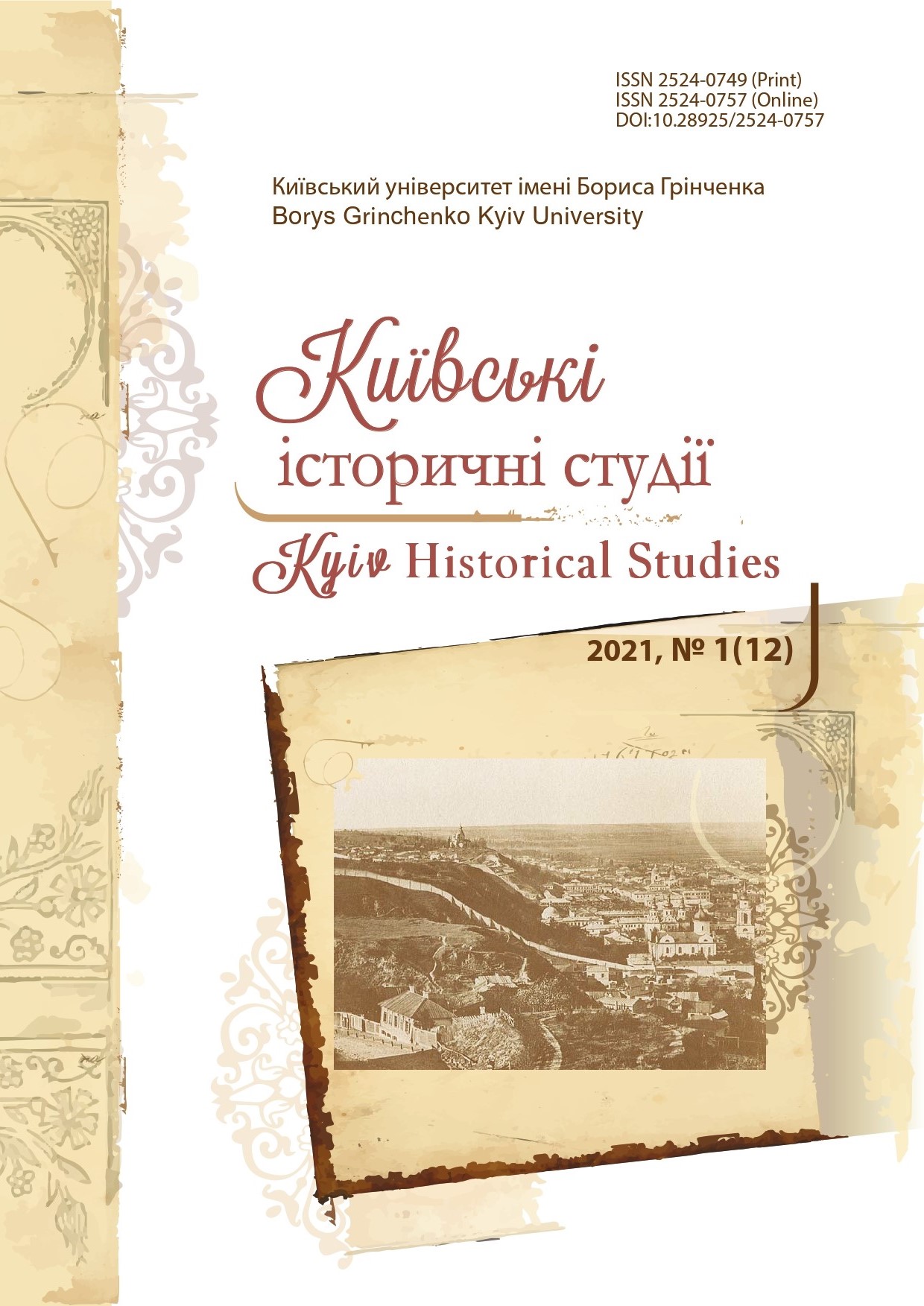Music in Social and Cultural Environment in a Noble Estate in the end of the 18th — the mid of the 19th century: from the History of Serf Orchestra of Galagan’s Family
DOI:
https://doi.org/10.28925/2524-0757.2021.17Keywords:
noble estate, Galagan’s family, music, serf orchestra, serf-musiciansAbstract
The issue of musical culture development in a noble estate in Ukraine from the end of the 18th — to the mid of the 19th century was considered in the article on the grounded source base. This objective has been realised via reconstruction of the creation and activity circumstances of serf orchestra belonged to Galagan’s family in the estates in Sokyryntsi and Digtiari. The purpose of the article is to analyse a summary of social and cultural factors that secured Galagan’s family estates as the centers of musical art in the atmosphere of which refined amateurship of the owners co-existed with high quality musical performance of the serf musicians. The author studies issues of inherited character of orchestra’s activity during the life of several generations of Galagan’s family in the estates in Sokyryntsi and Digtiari. Furthermore, the author considers in what way musical performance in the estates facilitated communication practices of the noble community. The main attention of the article is devoted to the issue of ambivalence of cultural space in the estates. Men from Galagan’s family were sincerely fond of music and simultaneously used it as a mean for their social status improving as well as for social reputation of their own estates. They provided an opportunity for the talented peasants to enhance the artistic abilities, secured their profession education. On the other hand, the serf-musicians remained slaves who were in complete power of their owners. The article is completed by a publication of two letters written during 1824–1831s by Petro Galagan, the owner of the estate in Digtiari to his brother Pavel who was the owner of Sokyryntsi. These texts depict the circumstances of Digtiari’s transformation into the representative residence where music played a crucial role as well as reveal the details of artistic atmosphere of the estate. The letters are published for the first time.
Downloads
References
Bebutov, D. O. (1902). Zapiski. Kavkazskii sbornik, 23, 37–74 [in Russian].
Bohdanov, V. O. (2006). Kriposni kapely і orkestry v Ukraini. Visnyk Kharkivskoi derzhavnoi akademii dyzainu і mystetstv, 11, 17–25 [in Ukrainian].
Budzar, M., Kovalov, Ye. (comps.), Kolesnyk I. (ed.). (2019). «My vyikhaly z Sokyryntsiv…»: trevelohy rodyny Galaganiv”. [“We Set off from Sokyrentsi…”: Galalgan’s family travelogues]. Kyiv: StreamARLine [in Ukrainian].
Budzar, M. & Kovalov, Ye. (2021). Odyn z Shevchenkovykh chytachiv: komentari Andronyka Stepovycha do povisti «Muzykant». In Taras Shevchenko ta yoho teksty: chytannia, interpretatsiia, komemoratsiia na mezhi XIX–XX stolit. Kyiv [in Ukrainian].
Galagan, G. P. (1882). Malorusskii vertep; P. I. Zhitetsckii (foreword). Kievskaia starina, 10, 1–38 [in Russian].
Galagan, H. P. (1896). Rod Galaganov. In Stepovich, A. I. (ed.), 25-letiie Kollegii Pavla Galagana v Kieve, pp. 1–2, Kyiv [in Russian].
Galagan, Gryhorii. Zhurnal (1836–1841). (2020). [The Diary of Hryhorii Galagan (1836–1841)]. M. Budzar, Ye. Kovalov (comps.), I. Kolesnyk (ed.). Kyiv: StreamARLine [in Ukrainian].
Dinges, M. (2000). Istoricheskaia antropologiia і kulturnaia istoriia: cherez teoriiu “stilia zhizni” k “kulturnoi istorii povsednevnosti”. In Odissei. Chelovek v istorii 2000, pp. 96–124, Moskva: Nauka [in Russian].
Ernst, F. (1924). Kripatski kapely na Ukraini. Muzyka, 1–3, 33–38; 10–12, 205–213 [in Ukrainian].
Ernst, F. (1924). Shche pro kripatski kapely na Ukraini. Muzyka, 4–6, 48–49 [in Ukrainian].
Grech, A. (1998). Muzyka v russkoi usadbe. Russkaia usadba, 4 [in Russian]. https://www.booksite.ru/usadba_new/world/16_4_02.htm
Jörn, L., Christian, W. (2011). Noble Identities from the Sixteenth to the Twentieth Century. European Aristocratic Cultures in Law, Politics and Aesthetics. In What makes the nobility noble?: comparative perspectives from the sixteenth to the twentieth century. Göttingen: Vandenhoeck & Ruprecht [in English].
Lazarevskii, A. (1883). Galaganovskii familnyi arkhiv. Kievskaia starina, VII, 432–471 [in Russian].
Matsenko, V. A. (1888). Prilukshina. Istoricheskoie і statisticheskoie opisanie territorii Prilukskogo uiezda Poltavskoi gubernii. Romny [in Russian].
Mitelman, Ye. (1989). Nove pro Shevchenkovogo muzykanta. Radianske literaturoznavstvo, 10, 70–71 [in Ukrainian].
Mitelman, Ye. (1985). Za riadkom Shevchenkovoi povisti. Muzyka, 1, 27–29 [in Ukrainian].
Nikolaichik, F. (1887). Rod Lashkevichei і dnevnik odnogo iz nikh. Kievskaia starina, XIX, 696–716 [in Russian].
Seleckii, P. D. (1884). Zapiski Petra Dmitrievicha Seletskogo. Kievskaia starina, 8, 622 [in Russian].
Scherbakivskyi, D. (1924). Orkestry, hory і kapely na Ukraini za panschyny. Muzyka, 4–6, 141–155; 10–12, 205–213 [in Ukrainian].
Shamaieva, K. (1984). Pobut Dehtiariv (seredyna XIX st.). Muzyka, 6, 24–25 [in Ukrainian].
Stepovych, A. (2019). Sokyrynskyi vertep. Fortetsia, 10, 30–33 [in Ukrainian].
Soloviev, K. A. (2013). «Vo vkuse umnoi stariny...» Usadebnyi byt rossiiskogo dvorianstva II poloviny XVIII — I poloviny XIX vekov, po vospominaniiam, pismam і dnevnikam. Moskva [in Russian].
Published
How to Cite
Issue
Section
License
Copyright (c) 2021 Марина Будзар

This work is licensed under a Creative Commons Attribution-NonCommercial-ShareAlike 4.0 International License.
Authors who publish in this journal retain the right of authorship of the work and give to the journal right of first publication of this work under the conditions of Creative Commons: Attribution-NonCommercial-ShareAlike 4.0 International (CC BY-NC-SA 4.0), which allows others freely distribute the work published with reference to the authors of the original work and the first publication of this magazine.














